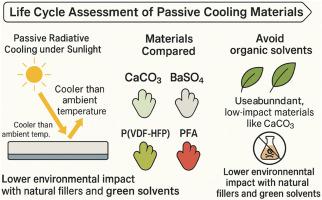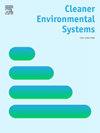被动辐射冷却材料的生命周期评价
IF 4.9
Q2 ENGINEERING, ENVIRONMENTAL
引用次数: 0
摘要
几十年来,被动冷却一直是研究兴趣的主题,因为它能够提供低成本的散热。最近,被动辐射冷却材料的科学取得了迅速的进展,即使在阳光直射下,原材料的合成也表现出低于环境温度,但这需要使用非常高体积分数的颜料。由于这些材料的开发仍处于研究阶段,因此对其环境影响有更深入的了解是很重要的。为此,在本研究中,对显示出在全日照下具有高发射率和反射率的被动冷却潜力的不同成分的材料进行了生命周期评估。研究的成分是基于碳酸钙、硫酸钡、P(VDF-HPF)和P(FA)聚合物,并对这些材料的生产进行了生命周期评估。结果表明,PFA的使用对聚合物基材料的环境影响最大。同时,以碳酸钙为基料,以水和乙醇为溶剂,碳足迹较低。总的来说,对于未来被动辐射冷却材料的制造,建议使用不需要大量加工和丰富的材料。最后,应该用更环保的物质代替有机溶剂。本文章由计算机程序翻译,如有差异,请以英文原文为准。

Life cycle assessment of passive radiative cooling materials
Passive cooling has been a subject of research interest for decades, due to its ability to provide low-cost heat rejection. Recently, the science of passive radiative cooling materials has shown rapid progress, with the synthesis of raw materials that exhibit lower-than-ambient temperature even under direct sunlight, which however requires the use of pigments at very high-volume fractions. As the development of these materials is still in the research stage, it is important to have a deeper understanding of their environmental impact. For this purpose, in this study, a life cycle assessment is performed on different compositions of materials that have shown the potential for passive cooling under full sunshine with high emissivity and reflectance The compositions studied are based on calcium carbonate, barium sulphate, P(VDF-HPF) and P(FA) polymers, with a life cycle assessment focused on the production of these materials. The results indicate that polymer-based material shows the highest environmental impact due to the use of PFA. In the meantime, the lower footprint is found for the calcium carbonate used as the base and water and ethanol as solvents. Overall, for the future fabrication of passive radiative cooling materials, it is suggested to use materials that do not require extensive processing and are abundant. Finally, organic solvents should be replaced by more environmentally friendly substances.
求助全文
通过发布文献求助,成功后即可免费获取论文全文。
去求助
来源期刊

Cleaner Environmental Systems
Environmental Science-Environmental Science (miscellaneous)
CiteScore
7.80
自引率
0.00%
发文量
32
审稿时长
52 days
 求助内容:
求助内容: 应助结果提醒方式:
应助结果提醒方式:


